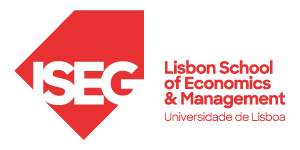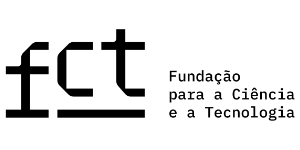Working Papers
For submission of articles or Working Papers to CEsA, please send an email to:
comunicacao@cesa.iseg.ulisboa.pt
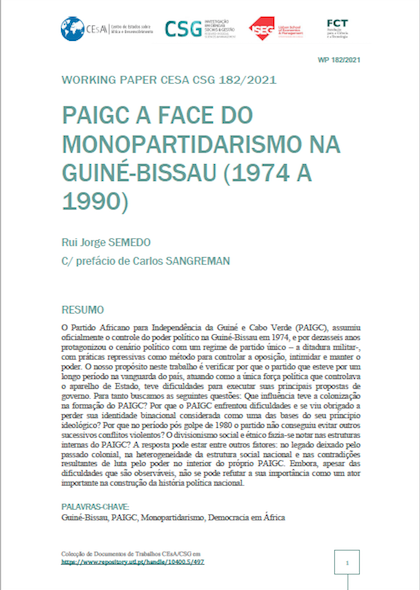
Working Paper 182/2021: PAIGC a Face do Monopartidarismo na Guiné-Bissau (1974 a 1990)
Abstract:
The African Party for Independence of Guinea and Cape Verde (PAIGC) officially took control of political power in Guinea-Bissau in 1974, and for sixteen years has starred in the political scene with a single-party regime – a military dictatorship–with repressive practices as a method to control the opposition, intimidate and maintain power. Our purpose in PAIGC a face do monopartidarismo na Guiné-Bissau (1974 a 1990) is to verify why the party that was for a long time at the forefront of the country, acting as the only political force that controlled the state apparatus, had difficulty executing its main government proposals. For this we seek the following questions: What influence did colonization have on the formation of the PAIGC? Why did the PAIGC face difficulties and were forced to lose its binational identity considered as one of the bases of its ideological beginning? Why in the post-coup period of 1980 could the party not prevent other successive violent conflicts? Was social and ethnic divisionism noted in the internal structures of the PAIGC? The answer may be among other factors: in the legacy left by the colonial past, in the heterogeneity of the national social structure and in the contradictions resulting from the struggle for power within the PAIGC itself. Although, despite the difficulties that are observable, it cannot be refuted its importance as an important player in the construction of national political history.
Quotation:
Semedo, Rui Jorge (2021). “PAIGC a face do monopartidarismo na Guiné-Bissau (1974 a 1990)”. Instituto Superior de Economia e Gestão – CEsA/CSG – Documentos de Trabalho nº 182/2021.
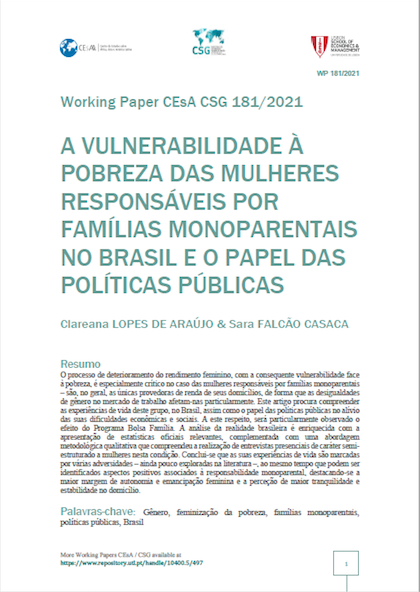
Working Paper 181/2021: A Vulnerabilidade à Pobreza das Mulheres Responsáveis por Famílias Monoparentais no Brasil e o Papel das Políticas Públicas
Abstract:
The deterioration of women’s income, and their consequent vulnerability to poverty, is particularly critical in the case of women who are the head of single-parent families – being them the only provider to the household, gender inequalities in the labor market affect them more significantly. A Vulnerabilidade à Pobreza das Mulheres Responsáveis por Famílias Monoparentais no Brasil e o Papel das Políticas Públicas seeks to understand the life experiences of these women, in Brazil, as well as the role of the State in alleviating their economic and social difficulties, where the effect of the Bolsa Família Programme will be studied in particular. The analysis of the Brazilian reality is enhanced by the presentation of relevant official statistics, complemented by a qualitative methodological approach based on semi-structured interviews conducted with women in this situation. It is concluded that their life experiences are affected by several hardships that are still relatively under-researched, but also by positive aspects related to their condition as single parents, above all in terms of their autonomy and perception of greater emancipation, as well as living in a safe and emotionaly stable environment.
Quotation:
Araújo, Clareana Lopes de e Sara Falcão Casaca (2021). “A vulnerabilidade à pobreza das mulheres responsáveis por famílias monoparentais no Brasil e o papel das políticas públicas”. Instituto Superior de Economia e Gestão – CEsA/ CSG – Documentos de Trabalho nº 181/2021.
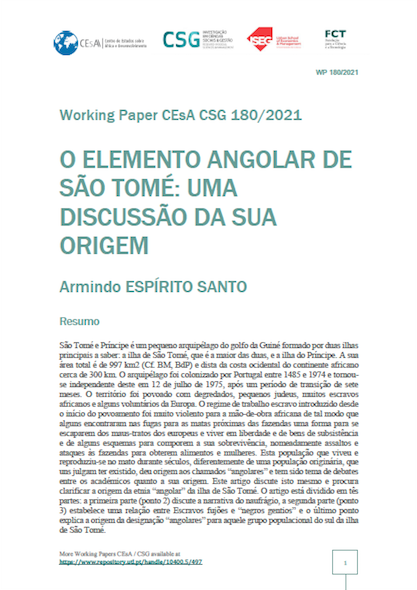
Working Paper 180/2021: O Elemento Angolar de São Tomé: Uma discussão da sua origem
Abstract:
São Tomé and Príncipe is a small archipelago in the Gulf of Guinea formed by two main islands, namely: the island of São Tomé, which is the larger of the two, and the island of Príncipe. Its total area is 997 km2 (Cf. BM, BdP) and is approximately 300 km from the west coast of the African continent. The archipelago was colonized by Portugal between 1485 and 1974 and became independent on July 12, 1975, after a seven-month transition period. The territory was populated with exiles, small Jews, many African slaves and some volunteers from Europe. The slave labor regime introduced since the beginning of the settlement was very violent for the African labor in such a way that some found in the escapes to the forests close to the farms a way to escape the mistreatment of the Europeans and live in freedom and subsistence goods and some schemes to compose their survival, namely assaults and attacks on farms to obtain food and women. This population that lived and reproduced in the bush for centuries, unlike an original population, which some believe to have existed, gave rise to the so-called “Angolas” and has been the subject of debates among academics as to its origin. This article discusses this and seeks to clarify the origin of the “Angolar” ethnic group on the island of São Tomé. O Elemento Angolar de São Tomé: Uma discussão da sua origem is divided into three parts: the first part (point 2) discusses the narrative of the shipwreck, the second part (point 3) establishes a relationship between fugitive slaves and “Black Gentiles” and the last point explains the origin of the designation “Angolas ” for that population group in the south of the island of São Tomé.
Quotation:
Santo, Armindo Espírito (2021). “O elemento angolar de São Tomé: uma discussão da sua origem”. Instituto Superior de Economia e Gestão – CEsA/ CSG – Documentos de Trabalho nº 180/2021.
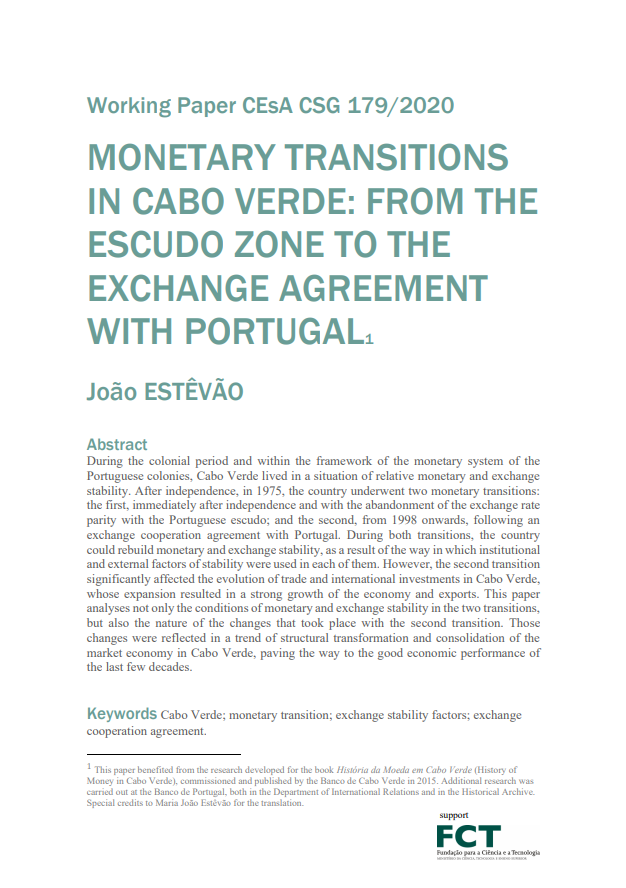
Working Paper 179/2020: Monetary Transitions in Cabo Verde: From the escudo zone to the exchange agreement with Portugal
Abstract:
Monetary Transitions in Cabo Verde: From the escudo zone to the exchange agreement with Portugal studies how, during the colonial period and within the framework of the monetary system of the Portuguese colonies, Cape Verde lived in a situation of relative monetary and exchange rate stability. After independence in 1975, the country underwent two monetary transitions: the first, immediately after independence and with the abandonment of parity with the Portuguese escudo; and the second, from 1998 onwards, following an exchange rate cooperation agreement with Portugal. During both transitions, the country was able to rebuild monetary and exchange rate stability, depending on how institutional and external stability factors were used in each of them. However, the second transition significantly affected the evolution of international trade and investment in Cape Verde, whose expansion resulted in strong growth in the economy and exports. This article analyses not only the conditions of monetary and exchange rate stability in the two transitions, but also the nature of the changes that occurred with the second transition. These changes translated into a trend of structural transformation and consolidation of the market economy in Cape Verde, paving the way for the good economic performance of recent decades.
Quotation:
Estêvão, João (2020). “Monetary transitions in Cabo Verde : from the escudo zone to the exchange agreement with Portugal”. Instituto Superior de Economia e Gestão – CEsA/ CSG – Documentos de Trabalho nº 179/2020.
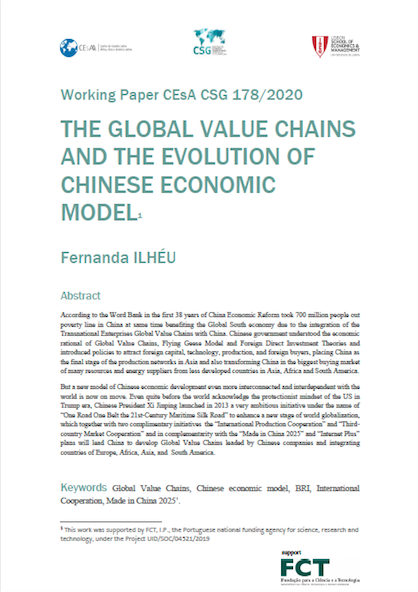
Working Paper 178/2020: The Global Value Chains and the Evolution of Chinese Economic Model
Abstract:
According to the Word Bank in the first 38 years of China Economic Reform took 700 million people out poverty line in China at same time benefiting the Global South economy due to the integration of the Transnational Enterprises Global Value Chains with China. Chinese government understood the economic rational of Global Value Chains, Flying Geese Model and Foreign Direct Investment Theories and introduced policies to attract foreign capital, technology, production, and foreign buyers, placing China as the final stage of the production networks in Asia and also transforming China in the biggest buying market of many resources and energy suppliers from less developed countries in Asia, Africa and South America. But a new model of Chinese economic development even more interconnected and interdependent with the world is now on move. Even quite before the world acknowledge the protectionist mindset of the US in Trump era, Chinese President Xi Jinping launched in 2013 a very ambitious initiative under the name of “One Road One Belt the 21st-Century Maritime Silk Road” to enhance a new stage of world globalization, which together with two complimentary initiatives the “International Production Cooperation” and “Third-country Market Cooperation” and in complementarity with the “Made in China 2025” and “Internet Plus” plans will lead China to develop Global Value Chains leaded by Chinese companies and integrating countries of Europe, Africa, Asia, and South America, studied in The Global Value Chains and the Evolution of Chinese Economic Model.
Quotation:
Ilhéu, Fernanda (2020). “The global value chains and the evolution of chinese economic model”. Instituto Superior de Economia e Gestão – CEsA/ CSG Documentos de Trabalho nº 178/2020.
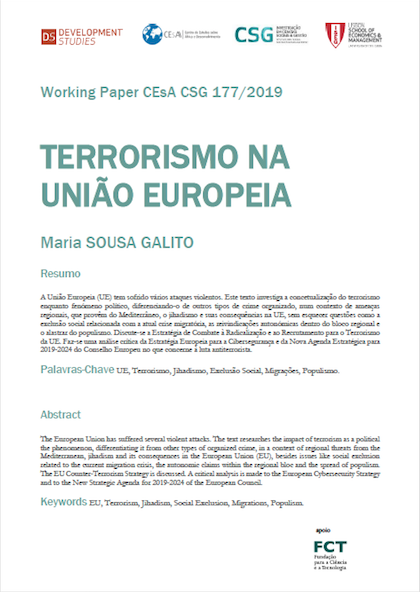
Working Paper 177/2019: Terrorismo na União Europeia
Abstract:
The European Union (EU) has suffered several violent attacks. Terrorismo na União Europeia investigates the conceptualisation of terrorism as a political phenomenon, differentiating it from other types of organised crime, in a context of regional threats, coming from the Mediterranean, jihadism and its consequences in the EU, without forgetting issues such as social exclusion related to the current migration crisis, autonomous claims within the regional bloc and the spread of populism. The EU Strategy for Combating Radicalisation and Recruitment to Terrorism is discussed. A critical analysis is made of the European Cybersecurity Strategy and the European Council’s New Strategic Agenda for 2019-2024 with regard to counter-terrorism. The idea is to confront legislative measures and to review precedents, within the framework of the Security Union and the Defence Union. The critical analysis of EU action is made on the basis of the challenges identified by the European Commission for the Community future, considering the Strategic Agenda 2019/2024, in a disruptive environment, in which the Community institutions have tried to be effective or even innovative and forerunners in terms of policy change.
Quotation:
Galito, Maria Sousa (2019). “Terrorismo na União Europeia”. Instituto Superior de Economia e Gestão – CEsA/CSG Documentos de Trabalho nº 177-2019.
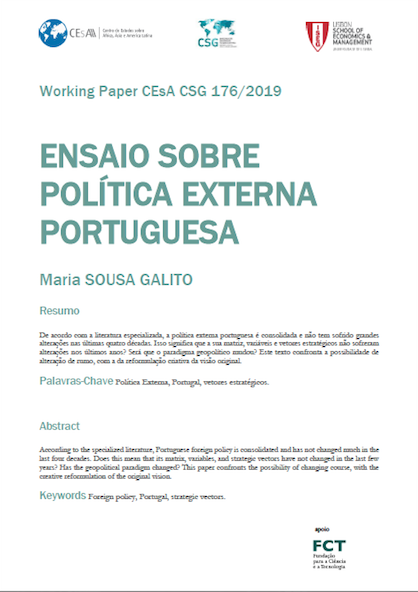
Working Paper 176/2019: Ensaio sobre Política Externa Portuguesa
Abstract:
In general, Portuguese foreign policy is “consolidated” and has not undergone “sudden changes of direction”. According to the national government, the founding matrix remains “well present and consolidated” although “denser, richer, broader”. What exactly does this mean? Our strategic vectors of foreign policy used to be three (Europe, Atlantic and Lusophony). Since the 1990s, some authors have admitted adding a complementary strategic pillar to the previous model. Which one? Three hypotheses. First, security, focusing on the international missions of the Portuguese Armed Forces within the framework of NATO (North Atlantic Treaty Organization), the EU (European Union) or the UN (United Nations). Secondly, cooperation, mainly technical and cultural, with Portuguese-speaking countries, but also with third countries. Thirdly, economic diplomacy, with exports, the diversification of the investment portfolio, the opening of the internal market to the world (and not only to the EU). According to specialized literature, Portuguese foreign policy is consolidated and has not undergone major changes in the last four decades. Does this mean that its matrix, variables and strategic vectors have not changed in recent years? Has the geopolitical paradigm changed? Ensaio sobre Política Externa Portuguesa confronts the possibility of a change of course, with that of the creative reformulation of the original vision.
Quotation:
Galito, Maria Sousa (2019). “Ensaio sobre política externa portuguesa”. Instituto Superior de Economia e Gestão – CEsA/ CSG – Documentos de Trabalho nº 176/2019.

Working Paper 175/2019: Sahel e Magreb: Ensaio sobre o Norte de África, uma região em convulsão
Abstract:
Sahel e Magreb : ensaio sobre o norte de África, uma região em convulsão focuses on the Sahel and on the Maghreb. The objective is to assess whether these regions are in crisis, with common problems affecting their countries; if there are specific characteristics limiting their development, and conflicts are justified by religious or economic issues, cultural patterns or local challenges. The study is macro. Debates the role of Fragile States with high violence, economic and social vulnerability, power struggles and fighting for natural resources. The paper is subdivided into two chapters. The first compares the Sahel and Maghreb regions, with a short analysis for each country that constitutes them, since the spaces are very related to each other, since traffickers transit along the trade routes of the ancient caravans of the desert caravans, or less watched over by law enforcement agents or controlled by guerrillas or or controlled by guerrilla or terrorist groups. Maps and statistical tables are offered for appropriate comparisons. The second chapter is about the influence of the Arab Spring in North Africa, with reference its main causes and consequences. Given that these states are considered fragile by the international community, the question is whether they are failures and why they have serious problems of governance, internal stability or the stability of their borders. It assesses the fight against terrorism, in a sensitive in a sensitive context where former guerrilla fighters are still active, part of militias or terrorist groups or claiming possession of natural resources, reclaiming for themselves the sources of income and the channels of distribution. sources of income and channels of distribution. Different types of violence or organised crime are also differentiated crimes.
Quotation:
Galito, Maria Sousa (2019). “Sahel e Magreb : ensaio sobre o norte de África, uma região em convulsão”. Instituto Superior de Economia e Gestão – CEsA/ CSG – Documentos de Trabalho nº 175/2019.
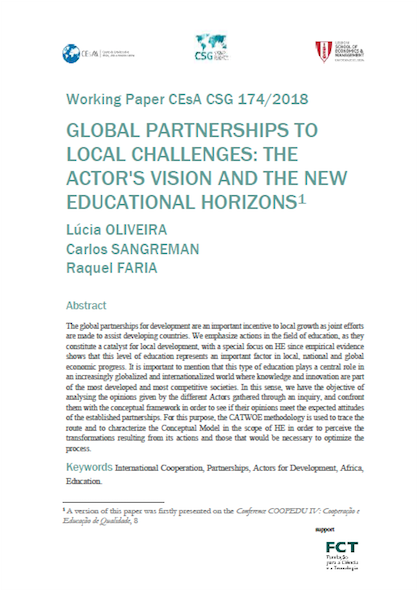
Working Paper 174/2018: Global Partnerships to Local Challenges: The actor’s vision and the new educational horizons
Abstract:
The global partnerships for development are an important incentive to local growth as joint efforts are made to assist developing countries. In Global Partnerships to Local Challenges: The actor’s vision and the new educational horizons we emphasize actions in the field of education, as they constitute a catalyst for local development, with a special focus on HE since empirical evidence shows that this level of education represents an important factor in local, national and global economic progress. It is important to mention that this type of education plays a central role in an increasingly globalized and internationalized world where knowledge and innovation are part of the most developed and most competitive societies. In this sense, we have the objective of analysing the opinions given by the different Actors gathered through an inquiry, and confront them with the conceptual framework in order to see if their opinions meet the expected attitudes of the established partnerships. For this purpose, the CATWOE methodology is used to trace the route and to characterize the Conceptual Model in the scope of HE in order to perceive the transformations resulting from its actions and those that would be necessary to optimize the process.
Quotation:
Oliveira, Lúcia, Carlos Sangreman e Raquel Faria (2018). “Global partnerships to local challenges: the actor’s vision and the new educational horizons”. Instituto Superior de Economia e Gestão – CEsA/ CSG Documentos de Trabalho nº 174/2018.
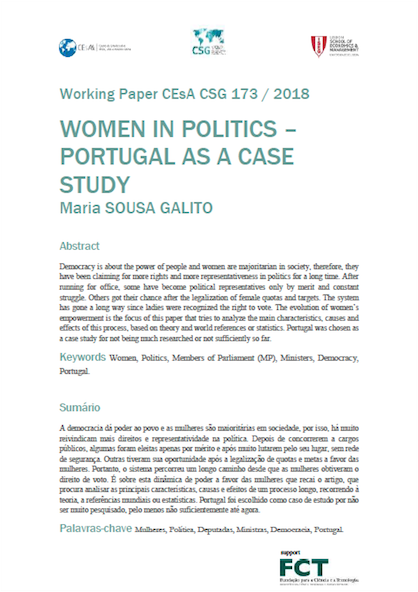
Working Paper 173/2018: Women in Politics: Portugal as a case study
Abstract:
Democracy is about the power of the people. In order to sustain, implies (at least) representativeness of its major groups. When majority rules minorities, lobbies complain when not happy and some of their demands are met; but the system doesn’t turn totally in their favor if it goes against the interests of a larger assembly. When minority rules the majority, problems arise (populism against elite, for instance); and sooner or later there’s a significant shift in society. Quantity gives power. Numbers do count in Democracy. Women are the majority of the population. It was not always so, but nowadays it’s an unquestionable fact. For cultural, institutional or socioeconomic reasons they were submissive for centuries to a system that did not recognize their public activity. They were not involved in decision making and rebel against that. At first, their demands were not met. But waves are changing. As long as democracy prevails and women’s numbers and percentages won’t drop, they’ll probably continue to raise awareness to their cause, increasing their power and influence in society. The evolution of women’s empowerment is the focus of Women in Politics: Portugal as a case study, that tries to analyze the main characteristics, causes and effects of this process, based on theory and world references or statistics. Portugal was chosen as a case study for not being much researched or not sufficiently so far.
Quotation:
Galito, Maria Sousa (2018). “Women in politics : Portugal as a case study”. Instituto Superior de Economia e Gestão – CEsA/ CSG – Documentos de Trabalho nº 173/2018.


